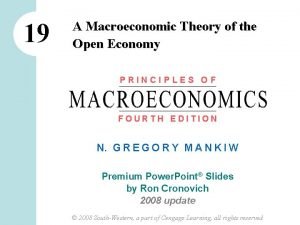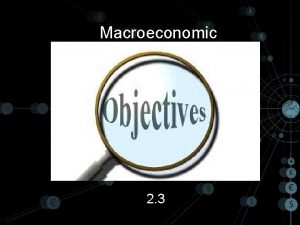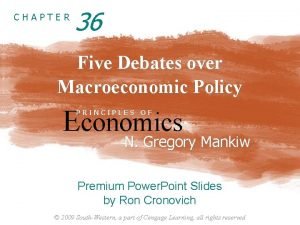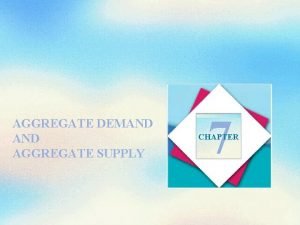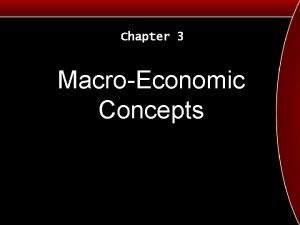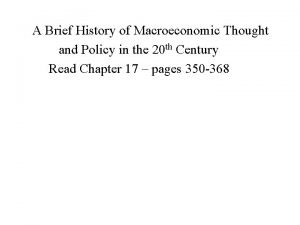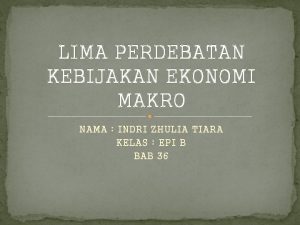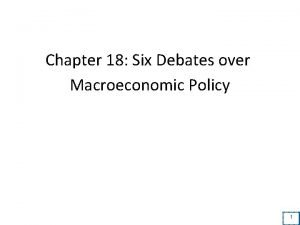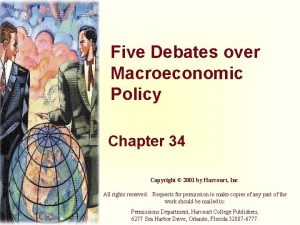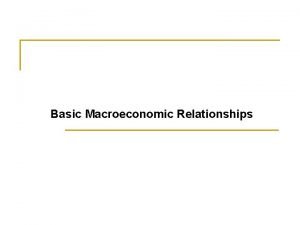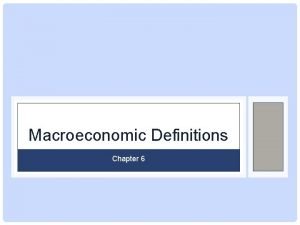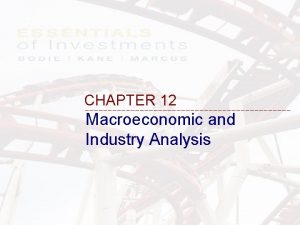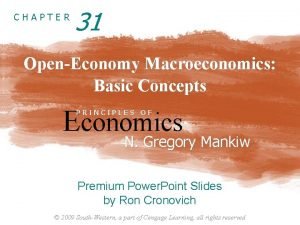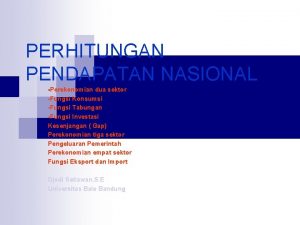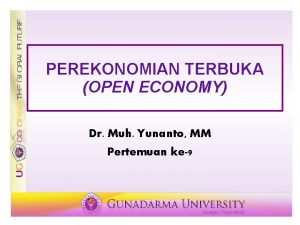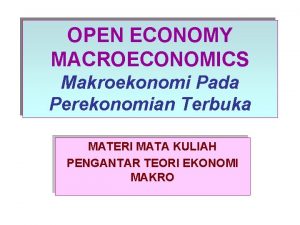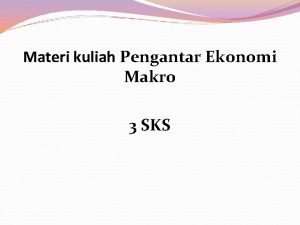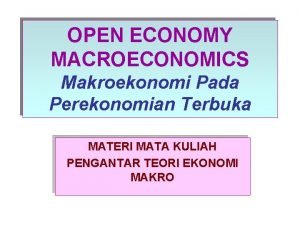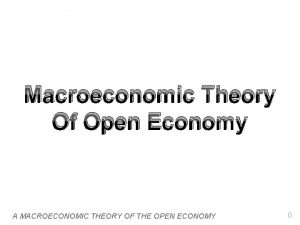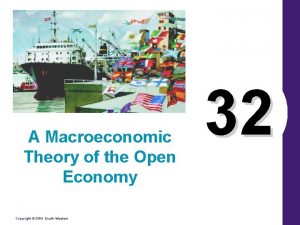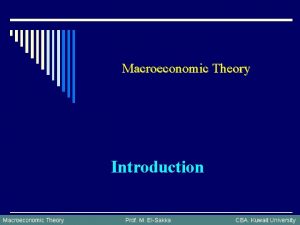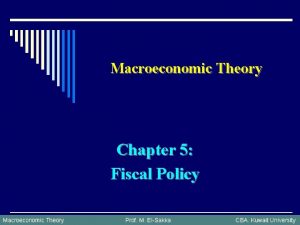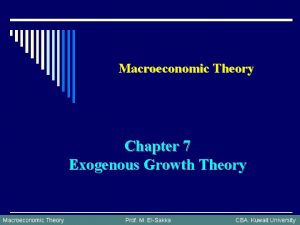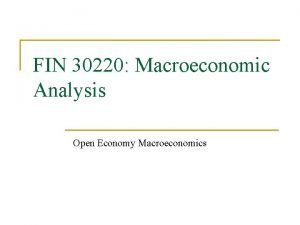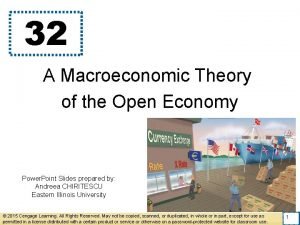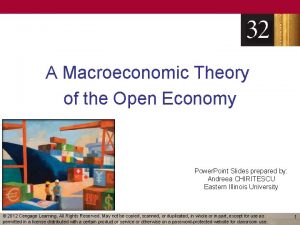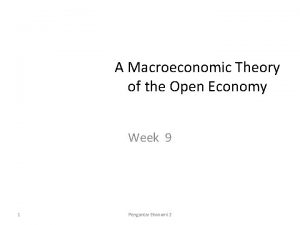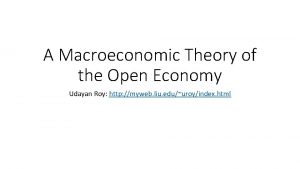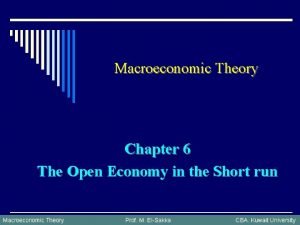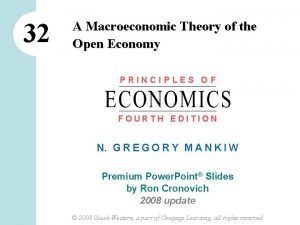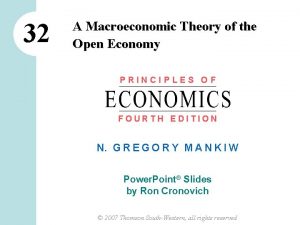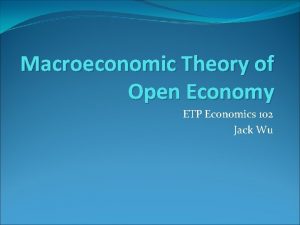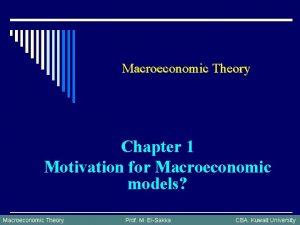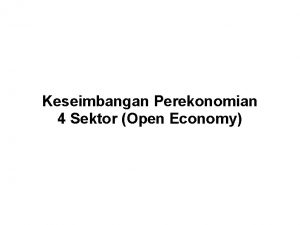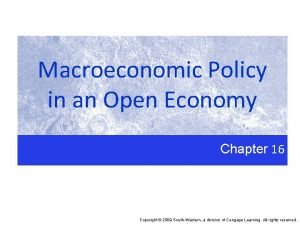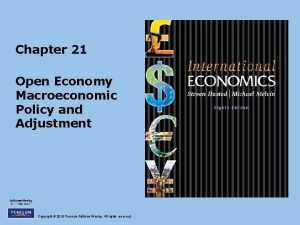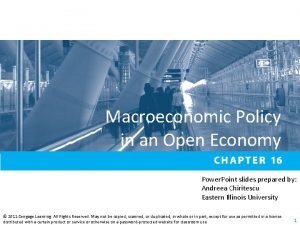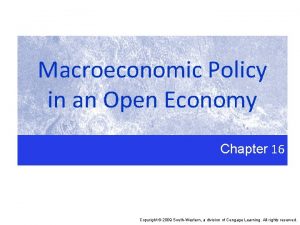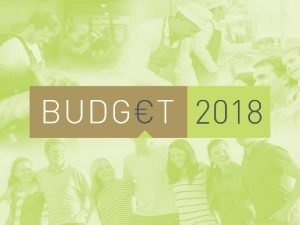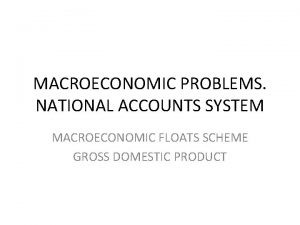A Macroeconomic Theory of the Open Economy Copyright














































- Slides: 46

A Macroeconomic Theory of the Open Economy Copyright © 2004 South-Western 32

Open Economies • An open economy is one that interacts freely with other economies around the world. Copyright © 2004 South-Western

Key Macroeconomic Variables in an Open Economy • The important macroeconomic variables of an open economy include: • • net exports net foreign investment nominal exchange rates real exchange rates Copyright © 2004 South-Western

Basic Assumptions of a Macroeconomic Model of an Open Economy • The model takes the economy’s GDP as given. • The model takes the economy’s price level as given. Copyright © 2004 South-Western

SUPPLY AND DEMAND FOR LOANABLE FUNDS AND FOREIGN-CURRENCY EXCHANGE • The Market for Loanable Funds S = I + NCO • At the equilibrium interest rate, the amount that people want to save exactly balances the desired quantities of investment and net capital outflows. Copyright © 2004 South-Western

The Market for Loanable Funds • The supply of loanable funds comes from national saving (S). • The demand for loanable funds comes from domestic investment (I) and net capital outflows (NCO). Copyright © 2004 South-Western

The Market for Loanable Funds • The supply and demand for loanable funds depend on the real interest rate. • A higher real interest rate encourages people to save and raises the quantity of loanable funds supplied. • The interest rate adjusts to bring the supply and demand for loanable funds into balance. Copyright © 2004 South-Western

Figure 1 The Market for Loanable Funds Real Interest Rate Supply of loanable funds (from national saving) Equilibrium real interest rate Demand for loanable funds (for domestic investment and net capital outflow) Equilibrium quantity Quantity of Loanable Funds Copyright© 2003 Southwestern/Thomson Learning

The Market for Loanable Funds • At the equilibrium interest rate, the amount that people want to save exactly balances the desired quantities of domestic investment and net foreign investment. Copyright © 2004 South-Western

The Market for Foreign-Currency Exchange • The two sides of the foreign-currency exchange market are represented by NCO and NX. • NCO represents the imbalance between the purchases and sales of capital assets. • NX represents the imbalance between exports and imports of goods and services. Copyright © 2004 South-Western

The Market for Foreign-Currency Exchange • In the market foreign-currency exchange, U. S. dollars are traded foreign currencies. • For an economy as a whole, NCO and NX must balance each other out, or: NCO = NX Copyright © 2004 South-Western

The Market for Foreign-Currency Exchange • The price that balances the supply and demand foreign-currency is the real exchange rate. Copyright © 2004 South-Western

The Market for Foreign-Currency Exchange • The demand curve foreign currency is downward sloping because a higher exchange rate makes domestic goods more expensive. • The supply curve is vertical because the quantity of TL supplied for net capital outflow is unrelated to the real exchange rate. Copyright © 2004 South-Western

Equilibrium in the FX market Real Exchange Rate 14 Supply of TL (for net foreign investment) Equilibium real exchange rate Demand for TL (from net exports) Equilibrium quantity Quantity of TL Exchanged into Foreign Currency

The Market for Foreign-Currency Exchange • The real exchange rate adjusts to balance the supply and demand for dollars. • At the equilibrium real exchange rate, the demand for dollars to buy net exports exactly balances the supply of TLs to be exchanged into foreign currency to buy assets abroad. Copyright © 2004 South-Western

EQUILIBRIUM IN THE OPEN ECONOMY • In the market for loanable funds, supply comes from national saving and demand comes from domestic investment and net capital outflow. • In the market foreign-currency exchange, supply comes from net capital outflow and demand comes from net exports. Copyright © 2004 South-Western

EQUILIBRIUM IN THE OPEN ECONOMY • Net capital outflow (net foreign invesment) links the loanable funds market and the foreigncurrency exchange market. • The key determinant of net capital outflow is the real interest rate. Copyright © 2004 South-Western

Figure 3 How Net Capital Outflow Depends on the Interest Rate Real Interest Rate Net capital outflow is negative. 0 Net capital outflow is positive. Net Capital Outflow Copyright© 2003 Southwestern/Thomson Learning

EQUILIBRIUM IN THE OPEN ECONOMY • Prices in the loanable funds market and the foreign-currency exchange market adjust simultaneously to balance supply and demand in these two markets. • As they do, they determine the macroeconomic variables of national saving, domestic investment, net foreign investment, and net exports. Copyright © 2004 South-Western

20 Equilibrium in the open economy (a) The Market for Loanable Funds Real Interest Rate (b) Net Foreign Investment Real Interest Rate Supply r 1 Net foreign investment, NFI Net Foreign Investment Demand Quantity of Loanable Funds Real Exchange Rate Supply E 1 Demand Quantity of TL (c) The Market for Foreign-Currency Exchange

Figure 4 The Real Equilibrium in an Open Economy (a) The Market for Loanable Funds Real Interest Rate (b) Net Capital Outflow Real Interest Rate Supply r r Demand Net capital outflow, NCO Quantity of Loanable Funds Net Capital Outflow Real Exchange Rate Supply E Demand Quantity of Dollars (c) The Market for Foreign-Currency Exchange Copyright© 2003 Southwestern/Thomson Learning

HOW POLICIES AND EVENTS AFFECT AN OPEN ECONOMY • The magnitude and variation in important macroeconomic variables depend on the following: • Government budget deficits • Trade policies • Political and economic stability Copyright © 2004 South-Western

Government Budget Deficits • In an open economy, government budget deficits. . . • • reduce the supply of loanable funds, drive up the interest rate, crowd out domestic investment, cause net foreign investment to fall. Copyright © 2004 South-Western

24 Budget deficit in open economy (a) The Market for Loanable Funds Real Interest Rate r 2 r 1 2. which increases the real interest S 2 (b) Net Foreign Investment Real Interest Rate S 1 B r 2 A r 1 3. which in turn reduces net foreign investment. Demand Quantity of Loanable Funds 1. A budget deficit reduces the supply of loanable funds. . . Net Foreign Investment Real Exchange Rate E 2 5. …which causes the real exchange rate toappreciate. NFI E 1 S 2 S 1 4. The decrease in net foreign investment reduces the supply of TL to be exchanged into foreign currency… Demand Quantity of TL (c) The Market for Foreign-Currency Exchange

Government Budget Deficits • Effect of Budget Deficits on the Loanable Funds Market • A government budget deficit reduces national saving, which. . . • shifts the supply curve for loanable funds to the left, which. . . • raises interest rates. Copyright © 2004 South-Western

Government Budget Deficits • Effect of Budget Deficits on Net Foreign Investment • Higher interest rates reduce net foreign investment. Copyright © 2004 South-Western

Government Budget Deficits • Effect on the Foreign-Currency Exchange Market • A decrease in net foreign investment reduces the supply of dollars to be exchanged into foreign currency. • This causes the real exchange rate to appreciate. Copyright © 2004 South-Western

Trade Policy • A trade policy is a government policy that directly influences the quantity of goods and services that a country imports or exports. • Tariff: A tax on an imported good. • Import quota: A limit on the quantity of a good produced abroad and sold domestically. Copyright © 2004 South-Western

Trade Policy • Because they do not change national saving or domestic investment, trade policies do not affect the trade balance. • For a given level of national saving and domestic investment, the real exchange rate adjusts to keep the trade balance the same. • Trade policies have a greater effect on microeconomic than on macroeconomic markets. Copyright © 2004 South-Western

Trade Policy • Effect of an Import Quota • Because foreigners need dollars to buy U. S. net exports, there is an increased demand for dollars in the market foreign-currency. • This leads to an appreciation of the real exchange rate. Copyright © 2004 South-Western

Trade Policy • Effect of an Import Quota • There is no change in the interest rate because nothing happens in the loanable funds market. • There will be no change in net exports. • There is no change in net foreign investment even though an import quota reduces imports. Copyright © 2004 South-Western

Trade Policy • Effect of an Import Quota • An appreciation of the TL in the foreign exchange market encourages imports and discourages exports. • This offsets the initial increase in net exports due to import quota. Copyright © 2004 South-Western

Import quota in open economy (a) The Market for Loanable Funds Real Interest Rate 33 (b) Net Foreign Investment Real Interest Rate Supply r 1 3. Net exports, however, remain the same. r 1 Demand NFI Net Foreign Investment Quantity of Loanable Funds Real Exchange Rate 2. and causes the real exchange rate to appreciate. E 2 Supply 1. An import quota increases the demand for TL… E 1 D 2 D 1 Quantity of TLs (c) The Market for Foreign-Currency Exchange

Trade Policy • Effect of an Import Quota • Trade policies do not affect the trade balance. Copyright © 2004 South-Western

Political Instability and Capital Flight • Capital flight is a large and sudden reduction in the demand for assets located in a country. Copyright © 2004 South-Western

Political Instability and Capital Flight • Capital flight has its largest impact on the country from which the capital is fleeing, but it also affects other countries. • If investors become concerned about the safety of their investments, capital can quickly leave an economy. • Interest rates increase and the domestic currency depreciates. Copyright © 2004 South-Western

Political Instability and Capital Flight • When investors around the world observed political problems in Mexico in 1994, they sold some of their Mexican assets and used the proceeds to buy assets of other countries. Copyright © 2004 South-Western

Political Instability and Capital Flight • This increased Mexican net capital outflow. • The demand for loanable funds in the loanable funds market increased, which increased the interest rate. • This increased the supply of pesos in the foreigncurrency exchange market. Copyright © 2004 South-Western

39 An attack on the TL (a) The Market for Loanable Funds in Turkey Real Interest Rate (b) Turkish Net Foreign Investment Real Interest Rate Supply r 2 r 1 3. …which increases the interest rate. 1. An increase in net foreign investment… D 2 D 1 NFI 2 Quantity of Loanable Funds 2. …increases the demand for loanable funds… Real Exchange Rate 5. …which causes the TL to depreciate E 1 Net Foreign Investment S 1 S 2 4. At the same time, the increase in net foreign investment increases the supply of TL… E 2 Demand Quantity of TL (c) The Market for Foreign-Currency Exchange

40 The logic of the markets • When economic actors expect things to go wrong in the country, they try to protect their savings from potential problems by sending them abroad • One way to solve this problem is to offer a higher interest rate to them so that they stay in domestic assets • Another way is for the economy to produce more FX by higher exports and lower imports so that the surplus can be invested abroad • That’s why the interest rate rises while the currency falls • It is all simple logic

41 February crisis in Turkey • When investors around the world observed the political problems in Turkey in February 2001, they sold some of their assets in TL and used the proceeds to buy assets in other countries • This corresponded to a big upward jump in Turkey’s NFI curve • Interest rates also jumped as demand for loanable funds was substantially increased because of the shift in the NFI curve • TL rapidly depreciated because of the excess supply of TL at the FX market despite the big hike in the real interest rate • That’s how markets work in an open economy

Summary • To analyze the macroeconomics of open economies, two markets are central—the market for loanable funds and the market foreign-currency exchange. • In the market for loanable funds, the interest rate adjusts to balance supply for loanable funds (from national saving) and demand for loanable funds (from domestic investment and net capital outflow). Copyright © 2004 South-Western

Summary • In the market foreign-currency exchange, the real exchange rate adjusts to balance the supply of dollars (for net capital outflow) and the demand for dollars (for net exports). • Net capital outflow is the variable that connects the two markets. Copyright © 2004 South-Western

Summary • A policy that reduces national saving, such as a government budget deficit, reduces the supply of loanable funds and drives up the interest rate. • The higher interest rate reduces net capital outflow, reducing the supply of dollars. • The dollar appreciates, and net exports fall. Copyright © 2004 South-Western

Summary • A trade restriction increases net exports and increases the demand for dollars in the market foreign-currency exchange. • As a result, the dollar appreciates in value, making domestic goods more expensive relative to foreign goods. • This appreciation offsets the initial impact of the trade restrictions on net exports. Copyright © 2004 South-Western

Summary • When investors change their attitudes about holding assets of a country, the ramifications for the country’s economy can be profound. • Political instability in a country can lead to capital flight. • Capital flight tends to increase interest rates and cause the country’s currency to depreciate. Copyright © 2004 South-Western
 A macroeconomic theory of the open economy
A macroeconomic theory of the open economy Athens vs sparta differences
Athens vs sparta differences 영국 beis
영국 beis Macroeconomic objectives
Macroeconomic objectives Five debates over macroeconomic policy
Five debates over macroeconomic policy Short run macroeconomic equilibrium
Short run macroeconomic equilibrium Macroeconomic deals withसमग्रलक्षी
Macroeconomic deals withसमग्रलक्षी History of macroeconomic thought
History of macroeconomic thought Perlukah pemerintah menyeimbangkan anggaran belanjanya
Perlukah pemerintah menyeimbangkan anggaran belanjanya Six debates over macroeconomic policy
Six debates over macroeconomic policy Five debates over macroeconomic policy
Five debates over macroeconomic policy Five debates over macroeconomic policy
Five debates over macroeconomic policy Basic macroeconomic relationships
Basic macroeconomic relationships Macroeconomic definitions
Macroeconomic definitions Macroeconomic and industry analysis
Macroeconomic and industry analysis Chapter 31 open economy macroeconomics
Chapter 31 open economy macroeconomics Open economy
Open economy Open economy
Open economy Open economy
Open economy Open economy
Open economy Open economy adalah
Open economy adalah Open source circular economy
Open source circular economy Hát kết hợp bộ gõ cơ thể
Hát kết hợp bộ gõ cơ thể Bổ thể
Bổ thể Tỉ lệ cơ thể trẻ em
Tỉ lệ cơ thể trẻ em Chó sói
Chó sói Chụp tư thế worms-breton
Chụp tư thế worms-breton Hát lên người ơi
Hát lên người ơi Các môn thể thao bắt đầu bằng tiếng nhảy
Các môn thể thao bắt đầu bằng tiếng nhảy Thế nào là hệ số cao nhất
Thế nào là hệ số cao nhất Các châu lục và đại dương trên thế giới
Các châu lục và đại dương trên thế giới Công của trọng lực
Công của trọng lực Trời xanh đây là của chúng ta thể thơ
Trời xanh đây là của chúng ta thể thơ Mật thư anh em như thể tay chân
Mật thư anh em như thể tay chân Làm thế nào để 102-1=99
Làm thế nào để 102-1=99 độ dài liên kết
độ dài liên kết Các châu lục và đại dương trên thế giới
Các châu lục và đại dương trên thế giới Thể thơ truyền thống
Thể thơ truyền thống Quá trình desamine hóa có thể tạo ra
Quá trình desamine hóa có thể tạo ra Một số thể thơ truyền thống
Một số thể thơ truyền thống Cái miệng nó xinh thế chỉ nói điều hay thôi
Cái miệng nó xinh thế chỉ nói điều hay thôi Vẽ hình chiếu vuông góc của vật thể sau
Vẽ hình chiếu vuông góc của vật thể sau Nguyên nhân của sự mỏi cơ sinh 8
Nguyên nhân của sự mỏi cơ sinh 8 đặc điểm cơ thể của người tối cổ
đặc điểm cơ thể của người tối cổ Giọng cùng tên là
Giọng cùng tên là Vẽ hình chiếu đứng bằng cạnh của vật thể
Vẽ hình chiếu đứng bằng cạnh của vật thể
